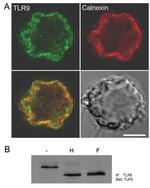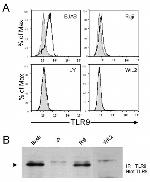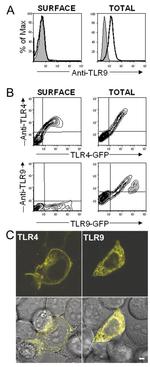Search Thermo Fisher Scientific
Invitrogen
CD289 (TLR9) Monoclonal Antibody (eB72-1665), eBioscience™
图: 1 / 6
CD289 (TLR9) Antibody (14-9099-82) in Flow
-Flow-20170216130641.jpg?time=20240507)





产品信息
14-9099-82
种属反应
已发表种属
宿主/亚型
分类
类型
克隆号
偶联物
形式
浓度
纯化类型
保存液
内含物
保存条件
运输条件
RRID
产品详细信息
Description: eB72-1665 is generated against a portion of human toll-like receptor 9 (aa 273-288), a molecule reported to be expressed predominantly intracellularly. TLR9 is a ~115-120 kDa molecule, which mediates response to unmethylated CpG dinucleotides in bacterial DNA. CpG DNA induces a strong T-helper-1-like inflammatory response and the proliferation of TLR9-positive human B cells. When stimulated with CpG DNA, TLR9-deficient (TLR9-/-) mice lacked splenocyte proliferation, inflammatory cytokine production from macrophages, and dendritic cell maturation, as compared with normal mice. To date, at least twelve members of the Toll family have been identified. This family of type I transmembrane proteins is characterized by an extracellular domain with leucine-rich repeats and a cytoplasmic domain with homology to the type I IL-1 receptor. Members of the TLR family are involved in recognition and response to different microbial components including lipoproteins, peptidoglycans, and nucleic acids and play important roles in innate immunity and inflammation. TLR9 is not detected by flow cytometry using this antibody on lysed whole human blood and/or isolated human PBMC stained for cell surface or intracellular TLR9. This may be due to limitations of antigen detection by flow cytometry. Human pDCs matured in the presence of IL-3 have been reported to stain with eB72-1665 by immunofluorescence microscopy (Nat Immunol. 5:190). Human Epithelial Cell lines were also reported to stain with this mAb (J. Immunol. 173: 1219). Further studies are needed to determine the relationship between mRNA expression and protein detection by flow cytometry.
Applications Reported: This eB72-1665 antibody has been reported for use in intracellular flow cytometric analysis, immunoprecipitation, and immunoblotting (WB). (Fluorochrome conjugated eB72-1665 is recommended for use in intracellular flow cytometry.) Preliminary in vitro blocking assays suggested that eB72-1665 may not be effective in blocking of CpG binding. Please contact us for further information.
Applications Tested: The eB72-1665 antibody has been tested by intracellular flow cytometric analysis of hTLR9 transfected cells. This can be used at less than or equal to 1 µg per test. A test is defined as the amount (µg) of antibody that will stain a cell sample in a final volume of 100 µL. Cell number should be determined empirically but can range from 10^5 to 10^8 cells/test. It is recommended that the antibody be carefully titrated for optimal performance in the assay of interest.
Purity: Greater than 90%, as determined by SDS-PAGE.
Aggregation: Less than 10%, as determined by HPLC.
Filtration: 0.2 µm post-manufacturing filtered.
靶标信息
The protein encoded by this gene is a member of the Toll-like receptor family which plays a fundamental role in pathogen recognition and activation of innate immunity. TLRs are highly conserved from Drosophila to humans and share structural and functional similarities. They recognize pathogen-associated molecular patterns that are expressed on infectious agents, and mediate the production of cytokines necessary for the development of effective immunity. The various TLRs exhibit different patterns of expression. This gene is preferentially expressed in immune cell rich tissues, such as spleen, lymph node, bone marrow and peripheral blood leukocytes. Studies in mice and human indicate that this receptor mediates cellular response to unmethylated CpG dinucleotides in bacterial DNA to mount an innate immune response.
仅用于科研。不用于诊断过程。未经明确授权不得转售。
生物信息学
蛋白别名: CD289; Toll-like receptor 9
基因别名: CD289; TLR9; UNQ5798/PRO19605
UniProt ID: (Human) Q9NR96
Entrez Gene ID: (Human) 54106

-Flow-20170216130641.jpg?time=20240507)

